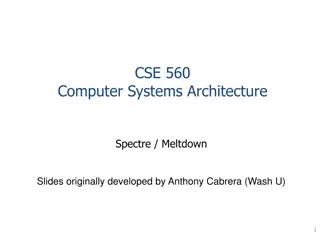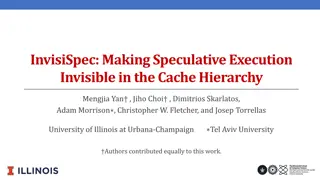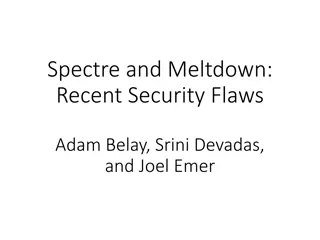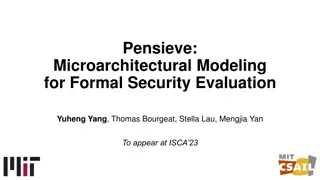
Unveiling the Threats of Meltdown and Spectre Attacks
Delve into the dangerous implications of Meltdown and Spectre attacks, capable of accessing sensitive information like passwords, keys, and credit card numbers. Understand the architecture tricks exploited and the challenges in defending against these sophisticated attacks.
Download Presentation

Please find below an Image/Link to download the presentation.
The content on the website is provided AS IS for your information and personal use only. It may not be sold, licensed, or shared on other websites without obtaining consent from the author. If you encounter any issues during the download, it is possible that the publisher has removed the file from their server.
You are allowed to download the files provided on this website for personal or commercial use, subject to the condition that they are used lawfully. All files are the property of their respective owners.
The content on the website is provided AS IS for your information and personal use only. It may not be sold, licensed, or shared on other websites without obtaining consent from the author.
E N D
Presentation Transcript
Meltdown and Spectre Vinod Ganapathy March 17, 2018
Why are the attacks so dangerous? Allow an attacker to read the contents of arbitrary memory locations on a victim computer: Stored passwords, cryptographic keys, credit card numbers, etc. The attacks do not exploit any known software vulnerabilities (at least not in the traditional sense). Defence proposed only for Meltdown, not Spectre. Proposed Meltdown defence has drawn criticism; is not yet reliable.
Why are the attacks so spectacular? Both attacks exploit tricks proposed in the computer architecture community decades ago! Meltdown exploits out-of-order execution. Spectre exploits speculative execution. Both tricks are completely standard and implemented by all modern processors. No flaw in the proposed design/specification of these architecture tricks. These tricks are now considered an essential part of the performance delivered by the processor. Cannot simply turn them off as a defence!
Outline Background Meltdown attack Spectre attack Open discussion: What went wrong? How can we fix it?
(Virtual) Address spaces Every process has a virtual address space: 4GB on 32-bit machines, ~281TB on 64-bit (only 48 bits currently used). Process code and data loaded/allocated into the address space. Every process's address space is isolated from every other process's address space BUT, kernel code and data loaded into every process's address space (e.g., top 1GB in the picture on the left, for 32-bit machines)
Isolating kernel memory from userland Userland code must not directly access kernel memory. Kernel contains sensitive info: Info about other processes. Typically, all of physical memory is mapped into the kernel address space. If userland code attempts to directly access kernel memory, hardware triggers an exception.
Virtual and physical memory The OS maps each process' virtual address space to physical memory via per-process page tables. Pages tables for all user processes are managed by the kernel, i.e., kernel knows virtual to physical mappings for all processes. Kernel itself is mapped into process address space: Kernel's own virtual to physical mappings are part of the page table.
The memory hierarchy On-chip caches provide fast access to data. Typically L1 and L2 private to individual cores (on multi-core machine) L3 is common to all cores (also called LLC). Caches store objects in cache-lines. Size of cache-line varies: e.g., 64 bytes on Core-i7 for L3 caches.
Building block: Cache-based covert-channels Goal: Player A uses the faster access times of cache memory as a side- channel to communicate with Player B Step 1: Flush the cache (so it s empty) clflush
Building block: Cache-based covert-channels Goal: Player A uses the faster access times of cache memory as a side- channel to communicate with Player B Step 2: Setup a probe array in memory. Array is set up such that each element of array occupies a different cache line Create a Probe Array in memory
Building block: Cache-based covert-channels Goal: Player A uses the faster access times of cache memory as a side- channel to communicate with Player B Step 3: Player B wants to communicate value X to Player A. He does so by accesses Probe_Array[X] To communicate X: Access index X
Building block: Cache-based covert-channels Goal: Player A uses the faster access times of cache memory as a side- channel to communicate with Player B Step 3: [Microarchitectural state change] That array element is loaded into the appropriate cache line Element loaded into cache
Building block: Cache-based covert-channels Goal: Player A uses the faster access times of cache memory as a side- channel to communicate with Player B Step 4: Player A reads Probe_Array sequentially and measures the access time for each array element. Read the probe array sequentially
Building block: Cache-based covert-channels Smaller read time when Probe_Array[X] is accessed
Side channels vs. Covert channels In a covert channel, the attacker controls both ends of the timing channel Can be used by attacker to transmit bits of information from one end to the other. Meltdown uses such a covert channel to read kernel memory from userland.
Building block: Out-of-order execution Allows instructions to execute speculatively, based on data availability, rather than execute instructions in program order. Key to high performance: when program completes "in order", speculative state will have computation results ready, so cycles are not wasted along the critical path. Example:
Building block: Out-of-order execution Above example was an instance of dynamic scheduling. Can also execute code with branches: requires branch prediction. An instance of speculative execution. Instructions execute speculatively out of order, but commit only when speculative state is concretized via actual execution. Instructions that have completed are said to have retired. Processors implement this using Tomasulo's algorithm.
Meltdown: The Covert Channel Setup A value of interest, stored in kernel memory (typically inaccessible to user processes) Forked child process (dies on exception, but affects cache state) Parent process
The Meltdown Attack Goal: Attacker wants to learn the value of the byte stored at a particular kernel memory address (address in the rcx register). Step 1: Reading the secret (Line 4) mov al, byte [rcx] Loads the byte value stored at the address RCX into AL (LSB of RAX) This instruction should cause an exception if executed in userland. Subsequent instructions should never be executed. BUT, due to OOO, subsequent instructions may already be executed speculatively. Exceptions handled only when Line 4 is retired. By then, microarchitectural state is already affected by subsequent OOO instruction execution.
The Meltdown Attack Goal: Attacker wants to learn the value of the byte stored at a particular kernel memory address (address in the rcx register). Step 2: Transmitting the secret (Line 5) shl rax, 0xc Multiply the byte value X by the page size (4K). This will be used to index into a probe array (base address in RBX). A large spatial distance ensures that neighboring locations of the probe array are not loaded into the cache (due to spatial locality optimizations). Probe array is of size 256 * 4K bytes, since we only have 256 possible byte values.
The Meltdown Attack Goal: Attacker wants to learn the value of the byte stored at a particular kernel memory address (address in the rcx register). Step 2: Transmitting the secret (Line 7) mov rbx, qword [rbx + rax] Read Probe_Array[X] (each entry is 4K bytes long). The value will be stored into the corresponding cache line Step 3: Receiving the secret (Parent process) Parent process probes the cache by iterating through Probe_Array[]. Only the read of Probe_Array[X] will be a hit in the cache. Attacker learns the value of X
The Meltdown Attack What is the role of line 3 and line 6? Race conditions! The attacker is racing against the hardware: Must get transient instructions to execute and affect microarchitectural state before the exception for line 4 is thrown. In some machines, exception is not handled, and process crashes, but processor zeroes out registers before crashing the process. If zeroing out happens faster than the operation in line 5, attacker will read the wrong value for X. So the code retries. Instruction sequence called a 0-noise-bias.
Meltdown attack application: Memory dumps Can iterate attack across a range of memory addresses to obtain a complete memory dump of the kernel. Physical memory on modern machines mapped at an offset within the kernel. So complete dump of physical memory is possible.
Meltdown attack application: Memory dumps Attack against Firefox56 running atop a Ubunto 16.10/Linux-4.8.0 machine on Intel Corei7-6700K
Meltdown attack status Applied successfully on several Intel processors on various OSes (Linux-2.6.32 to 4.13.0), Windows 10, Docker, LXC, and OpenVZ. Proposed defense: KPTI (Kernel Page Table Isolation). Being integrated into various OSes. Long-term effectiveness is unclear. Performance impact. But some novel solutions since
Summary of Meltdown Use OOO to execute an instruction that would normally raise an exception, and use it to read a secret from kernel memory. Transmit that secret to microarchitectural (cache) state. Read the cache state using a colluding process No host program required: self-contained with a parent+child attacking process. Only Intel processors affected. A fix has been proposed and is being deployed
Spectre Affects a wide variety of processors (Intel, ARM, AMD). Uses another form of speculative execution: branch prediction. Slightly harder to deploy than Meltdown, in that a host program is required, which contains certain instruction sequences that can be misused. No fixes are known to date.
Building block: Branch prediction In OOO, what happens when the speculative execution engine reaches a branch? Hardware branch predictor predicts a likely outcome of the branch (based on past history), and continues to speculate along the (likely) taken branch. TRUE branch st ld ld cmp jz Instruction stream FALSE branch
Building block: Branch prediction In OOO, what happens when the speculative execution engine reaches a branch? Hardware branch predictor predicts a likely outcome of the branch (based on past history), and continues to speculate along the (likely) taken branch. Concrete execution Speculation TRUE branch st ld ld cmp jz Instruction stream FALSE branch
Building block: Branch prediction In OOO, what happens when the speculative execution engine reaches a branch? Hardware branch predictor predicts a likely outcome of the branch (based on past history), and continues to speculate along the (likely) taken branch. Concrete execution Speculation Branch predictor predicts that this is the likely branch that is taken TRUE branch st ld ld cmp jz Instruction stream FALSE branch
Basic setup of Spectre attack In a host program (the victim of the attack), find an instruction sequence with a branch. Preparation: Execute the program to train the branch predictor to go in one direction (say, TRUE) Attack: Feed it a malicious input that would cause the branch to go the other direction (i.e., FALSE), but rely on branch predictor to execute the TRUE branch. Use the speculatively executed TRUE branch to extract data from the victim program.
Consider a host program with this snippet array1 is a unsigned byte array of size array1_size array2 is of size 64KB (256*256) Suppose the value of x is derived from user input to the program (and can therefore be controlled by attacker). In this program, there is some secret data S that you wish to access
Consider a host program with this snippet S array1_size DIS array1 Observe: array1[DIS] obtains S
Attack preparation 1. Execute the program long enough with a number of values of x, so that the branch predictor is trained to take the true branch. 2. Arrange for cache to not contain array2 and array1_size. 3. Arrange for cache to contain secret value S. How? E.g., S could be a cryptographic key you want to learn. Arrange for a cryptographic computation to happen that uses S.
Actual Spectre attack Now execute the program with x = DIS 1. x < array1_size will lead to a cache miss. Leads to a delay in fetching array1_size. Processor speculates on branch. 2. Speculative code reads array1[DIS]. A hit in the cache (the value S) 3. Code then proceeds to read array2[S*256]. A miss in the cache. However, array1_size may have arrived by then. Processor realizes mistake in speculation. But too late the speculative read array2[S*256] already affects cache state
Actual Spectre attack However, array1_size may have arrived by then. Processor realizes mistake in speculation. But too late the speculative read array2[S*256] already affects cache state. If array2 is accessible to the attacker, just probe all its elements and use cache-timing to figure out the value of S. (Many options possible here to transmit the microarchitectural state to the attacker).
Notes about Spectre Not restricted to host programs that have such a convenient code sequence built in. Can search for gadgets (short instruction sequences) that can be weaved together to achieve desired effect ( Return-oriented Programming , for those students who took my E0-256 course) Not restricted to conditional branches. Attack also adapted to work with indirect branches.
Spectre attack application: Breaking out of sandboxes JavaScript code that executes on your browser runs in a sandbox. Generally does not have access to browser state, except those explicitly exported to it. For example, this ensures that the JavaScript code that you get from Google when you read Gmail is unable to access your browsing history. Spectre can be used to create JavaScript code that breaks out of this sandbox to access arbitrary browser memory. Same basic idea as I described.










